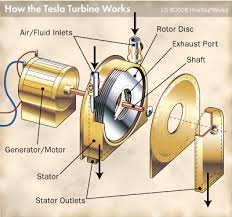 https://en.wikipedia.org/wiki/Tesla_turbine
https://en.wikipedia.org/wiki/Tesla_turbineFor those not familiar with the Tesla turbine, it's a bladeless design that uses the boundary layer effect and the adhesion and viscosity of fluids, including air, to turn the rotor and which can achieve 96-98% efficiency and extremely high RPM's.They are fascinating in and of themselves, but I had an idea for using the which could give us huge amounts of tidal power on both the flood and ebb.
In some areas of the UK, like the Bristol channel for example, have huge tidal ranges in excess of thirty feet. Imagine huge caverns (volumes in the region of cubic miles) dug inland and lined with concrete whose bottoms communicate thru huge pipes to the sea, below the level of tow tide so that they are permanently covered even at LAT (Lowest astronomical tide). The tops of these caverns funnel in size down to a 2ft or so pipe connected via valves to both inlet and outlet ports of a bank of TT's hooked up to generators. Whichever port (in or out) of the TT is connected to the other is connected to a very large diameter access to the open air.
At slack water, low tide, the valves will connect the inlet of the TT with the underground chamber and the outlet with the open air. As the flood begins air is forced into the turbine, which begins to spin. What makes these turbines so efficient is the fact that as the closely spaced blades begin to spin due to the adhesion of the air to the smooth surface, it forces the air-stream outwards by centripedal force, but it has to reach the holes in the blades near the hub before it can leave the turbine. As it does so it is forced into narrower and narrower streams as it is affected by the airstream closer to the centre and the new air coming in. This squeezing of the airstream forces it to cover every part of the blade surface for the longest time possible before it exits the turbine.
When the tide reaches high-tide you get around half an hour of slack water again in which time the valves are switched over so the air to fill the chambers as the water level drops will have to come through the turbines' inlet ports. This way the only time the turbines will not be turning and producing power are the two periods of slack water every 24hrs. Obviously the range of the tide varies with the waxing and waning of the moon between springs and neaps, so the chambers would have to be deep enough to cope with the highest possible astronomical tidal range with 20-30ft of storm surge on top for good measure (I've been in a marina when the pontoons nearly floated off their risers, 20ft high at normal high water), so the power generated will fluctuate accordingly, but other than that it will be constant, clean and most certainly not free. Nothing made by us that spends any time at all in seawater can survive without regular maintenance and the actual construction will be a major civil engineering undertaking, but every nation could use more jobs like those!
I will draw a diagram in case I haven't explained it very well, which is the usual way of things, and would also like to knock up a scale model at some point, but on initial impressions what do you guys think?

 http://large.stanford.edu/courses/2012/ph240/nam1/
http://large.stanford.edu/courses/2012/ph240/nam1/